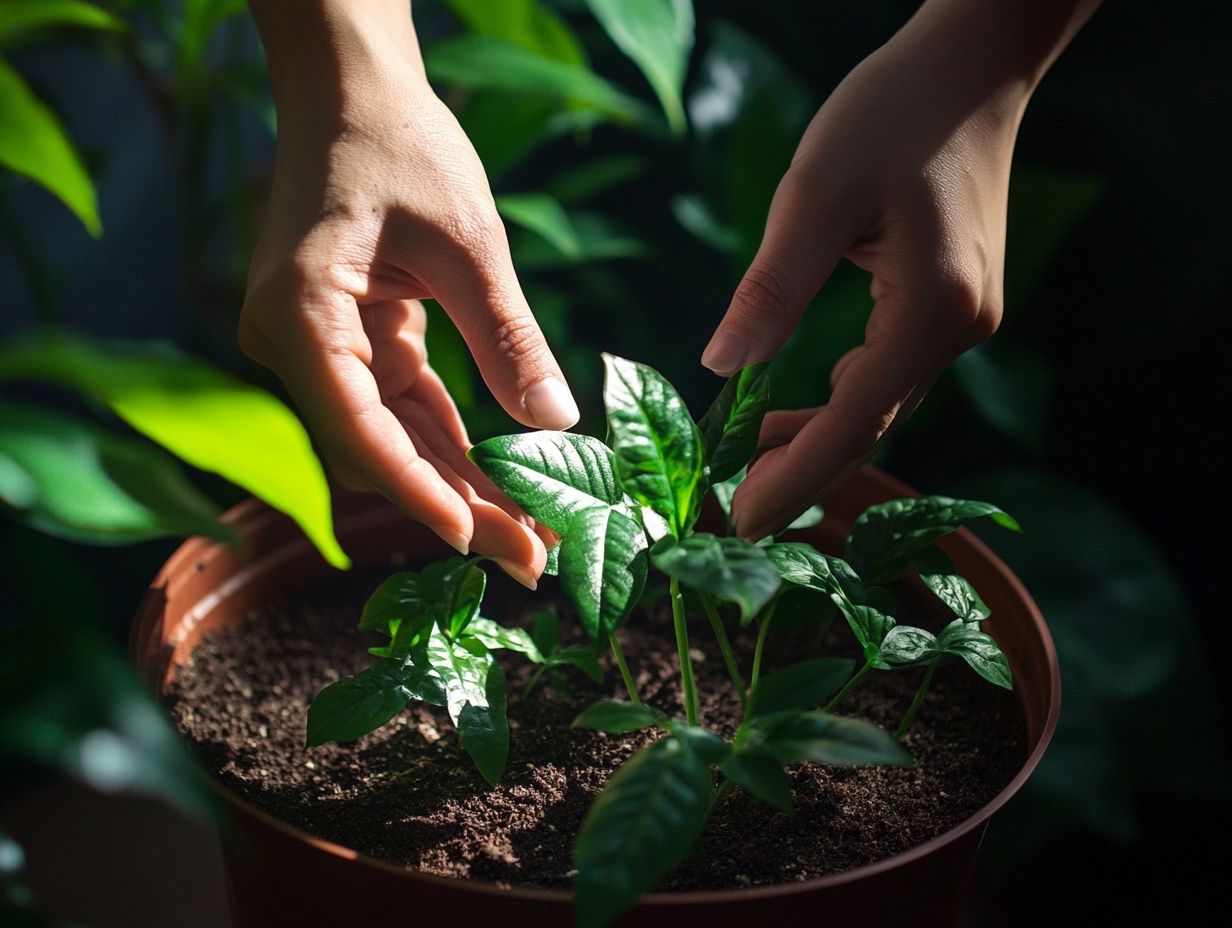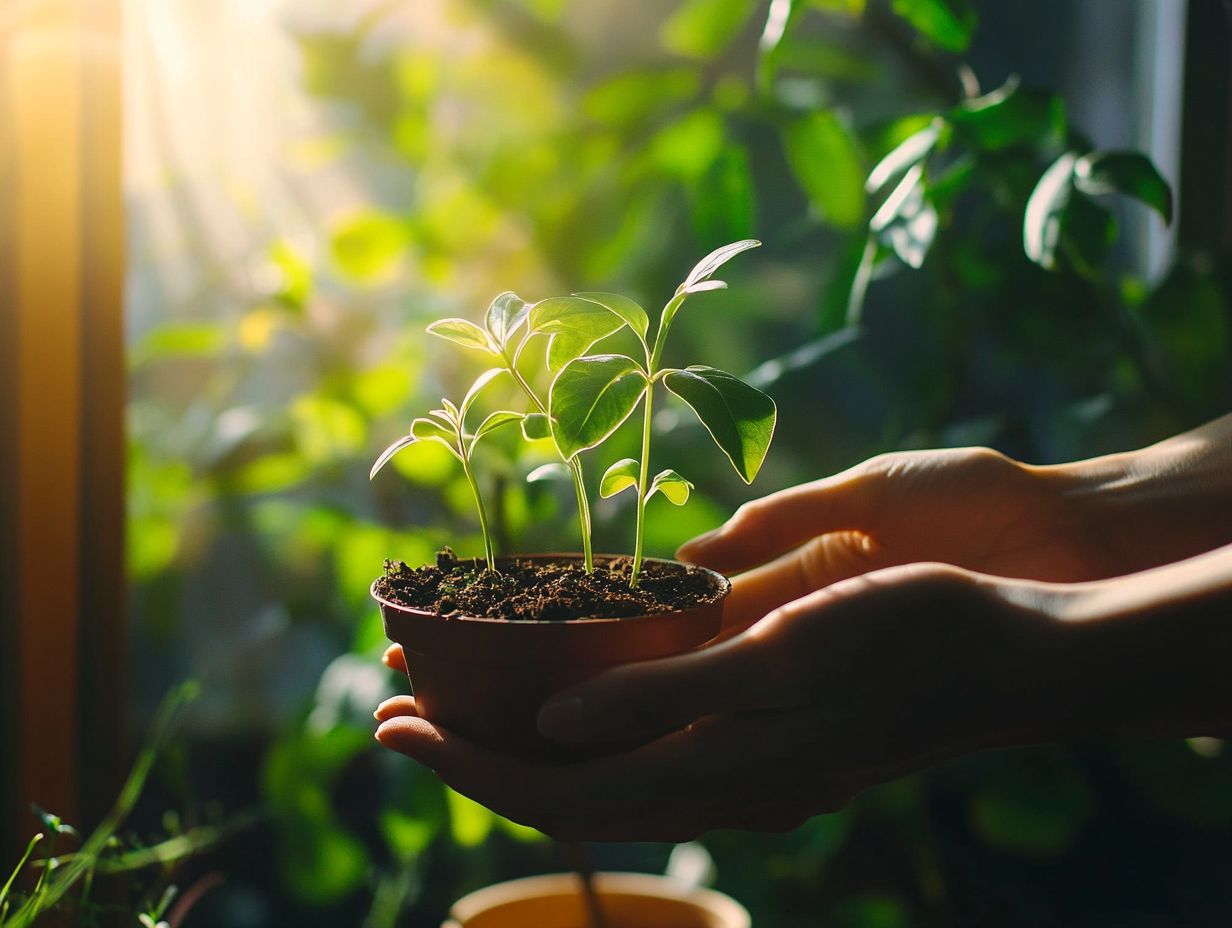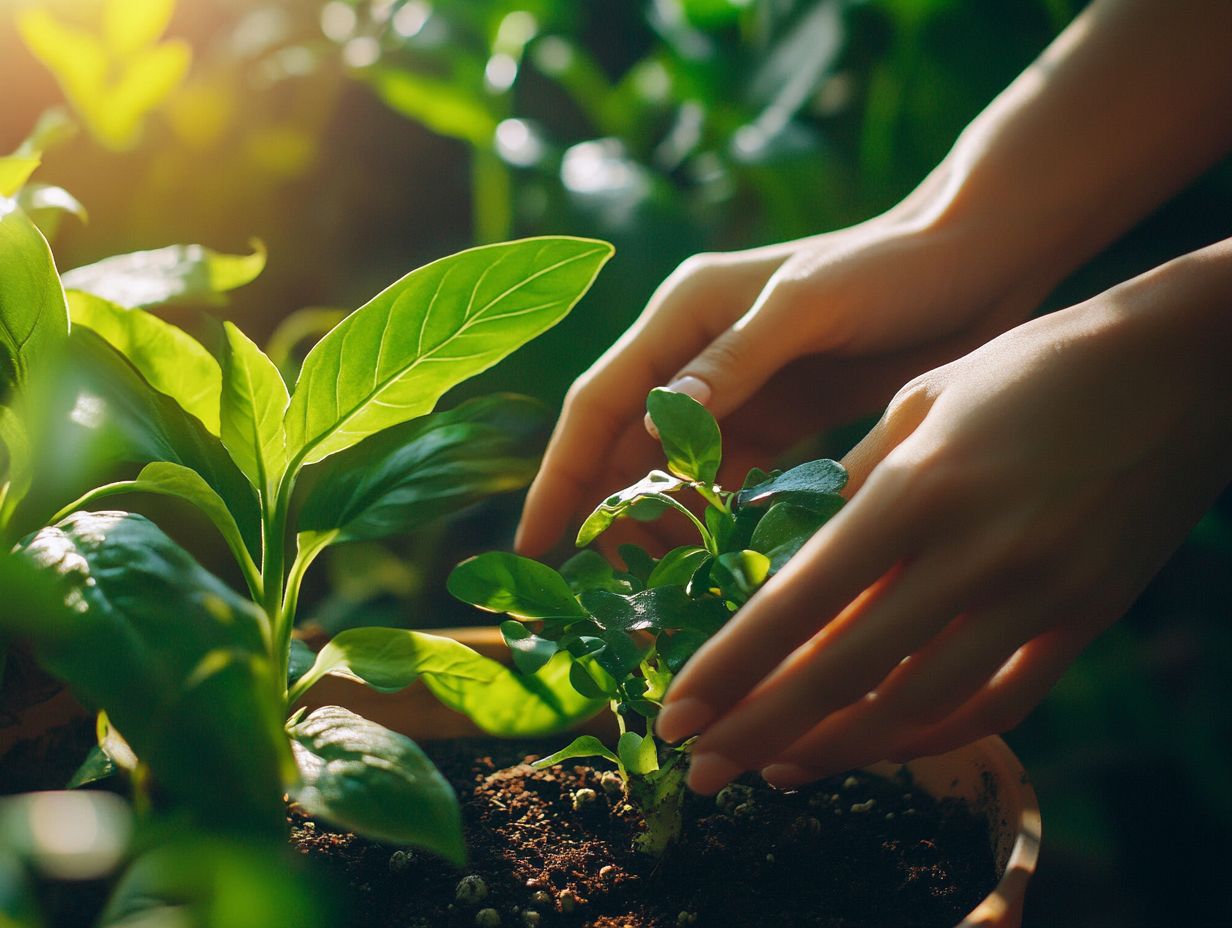The Importance of Sustainable Tourism
Growing new plants from cuttings is an exciting and easy way to expand your garden, especially for gardening enthusiasts. This method eliminates the need for seeds or costly nursery stock.
This guide reveals the benefits of this method of growing new plants, highlighting its advantages over traditional techniques. You ll learn how to select the right plant and cutting, prepare it for planting, and provide the essential care needed for healthy growth.
We will also discuss common mistakes and share troubleshooting tips to ensure your cutting process is smooth and fulfilling.
Whether you re a seasoned gardener or just starting, this guide will empower you to cultivate thriving new plants from cuttings. Start your journey today!
Contents
- Key Takeaways:
- Benefits of Growing Plants from Cuttings
- Choosing the Right Plant and Cutting
- Preparing the Cutting for Planting
- Planting and Caring for the Cutting
- Common Mistakes and How to Avoid Them in Plant Propagation
- Troubleshooting Common Issues in the Cutting Process
- Frequently Asked Questions about Cutting Techniques
- What are cuttings and how can they be used to grow new plants like roses and philodendrons?
- What are the different types of cuttings, including herbaceous and woody plants, and which one should I use?
- How do I prepare the cutting for propagation using proper cutting techniques?
- What is the best way to root the cutting using different propagation methods?
- How long does it take for cuttings to grow into new plants under optimal growing conditions?
- Are there any tips for increasing the success rate of propagating from cuttings using proper techniques?
Key Takeaways:

- Growing new plants from cuttings is a cost-effective and efficient way to expand your garden.
- The success of growing from cuttings depends on factors like plant selection, proper preparation, and care.
- To ensure successful plant propagation, avoid common mistakes and troubleshoot issues promptly.
Understanding Cuttings
Cuttings are a fundamental technique in gardening that allows you to use part of a plant typically a stem or leaf to grow new plants. This makes the process easy and efficient.
This method is a favorite among both novice and experienced gardeners, as it enables you to create exact replicas of your cherished houseplants and garden favorites, like roses and Philodendron, without the hassle of seeds.
The process is straightforward and applies to a wide variety of plant species, making it accessible for nurturing both leafy and woody plants.
There are three primary types of cuttings important for plant propagation:
- Stem cuttings: Take a section of the stem.
- Leaf cuttings: Use a single leaf. For detailed methods, refer to our step-by-step guide to leaf cuttings.
- Root cuttings: Focus on sections of roots.
Each type has unique advantages, particularly in root development and efficiency. For instance, stem cuttings root more readily and produce vigorous plants quickly, making them popular for propagating indoor plants.
This method is not only effective but also economical and immensely satisfying, ideal for those looking to expand their collection of garden plants.
Iconic houseplants like Philodendron and Monstera deliciosa are often propagated with this technique, making it a go-to strategy for anyone wishing to grow their green collection reliably.
Benefits of Growing Plants from Cuttings
Growing plants from cuttings presents a wealth of advantages that can elevate your gardening experience. This method allows you to efficiently reproduce your favorite species, including herbaceous plants (those with soft stems) and woody plants, ensuring new plants mirror the desirable traits of the parent.
Using cuttings leads to quicker root growth compared to starting from seeds. This results in healthier plants that thrive in various settings whether indoors or in a greenhouse.
Advantages over Other Plant Propagation Methods
The advantages of using cuttings over other plant propagation methods, like seeds or division, are substantial and can truly streamline your gardening experience. For instance, when you take cuttings, you replicate the specific characteristics of healthy plants, ensuring that your new plants display the same desirable traits.
This method often demands less time and fewer resources, making it the ideal choice for busy gardeners who want to cultivate leafy or woody plants without the lengthy waiting periods typical of seeds.
Choosing cuttings helps you avoid potential issues with soil pathogens that might affect seedlings, thus ensuring a healthier planting area. Using rooting hormone encourages faster and more vigorous root development, particularly when propagating tough plant species like Monstera deliciosa or clematis.
In contrast, seed propagation can expose your young plants to various environmental stresses during germination, which can hinder their growth.
With cuttings, achieving optimal growing conditions like maintaining humidity and temperature becomes much easier. This controlled environment ultimately leads to healthier plants, making your gardening journey incredibly rewarding!
Choosing the Right Plant and Cutting
Selecting the right plant and cutting is vital for success in plant propagation, particularly when considering seasonal planting and the specific growing conditions of different plant species. Not every plant is ideal for propagation from cuttings, so understanding the nuances of different species like roses, coleus, and clematis empowers you to make informed decisions.
Key factors to consider include the type of cutting, the season, and the specific growing conditions each plant requires, especially regarding moisture levels. By thoughtfully evaluating these elements, you can ensure that your chosen cutting will flourish when it s eventually transplanted into an appropriate potting medium or planting tray, such as a soilless mix.
Factors to Consider

When considering the factors for successful propagation from cuttings, several key elements like monitoring moisture levels must be taken into account to ensure that your cutting process yields new plants with robust root systems. Pay attention to the moisture level of the potting medium, maintain appropriate humidity for optimal root development, and create the right conditions in your growing area.
Understanding these factors enables you to cultivate the ideal environment for your cuttings, facilitating quicker and healthier growth.
For instance, selecting the right potting medium, such as a mix of peat moss, perlite, and vermiculite, is crucial, as it significantly influences how moisture is retained around your cutting. Your planting area should be situated in an area that receives indirect sunlight, preventing overheating and ensuring your cuttings don t dry out.
Monitoring humidity levels is essential; employing a humidity dome or using a plastic bag to maintain the right conditions can keep moisture levels in check without the risk of waterlogging. Additionally, check the moisture in the potting mix frequently, ensuring it remains consistently damp but not soggy.
Preparing the Cutting for Planting
Preparing your cutting for planting is an essential step in achieving successful propagation. Using a sharp knife ensures clean cuts, greatly enhancing the chances of robust root development and overall plant vitality.
Start by selecting a healthy plant cutting, such as stems from crepe myrtle or forsythia, and treat it with rooting hormone to encourage faster root growth. Ensure that the cutting is free from soil pathogens that could impede its progress.
By laying this groundwork, you’re setting the stage for a strong, healthy plant that will thrive once it s settled into its new growing medium and embraced by the right watering method.
Steps for Preparing the Cutting
Preparing your cutting is simple but critical for successful propagation.
These steps boost the chances of rooting and protect both the cutting and the parent plant. Start by gathering clean tools to prevent any diseases that could hinder growth.
Trim the cutting to a length of 6 to 8 inches. Pay attention to the nodes the small bumps where roots grow from the cutting they’re vital for root development.
Apply rooting hormone and place your cutting in a potting medium like a perlite and peat moss mix. Keep an eye on the moisture levels; too much can cause rot while too little can inhibit growth. Striking the right balance is key to nurturing thriving new plants. For more guidance, check out our tips on how to water plant cuttings effectively.
Planting and Caring for the Cutting
Planting and nurturing a cutting goes beyond simply inserting it into the soil; it s about creating the ideal conditions that promote its growth into a thriving plant.
After preparing the cutting and placing it in a suitable potting medium or planting tray, ensure it gets plenty of bright light, but avoid direct sunlight. Maintain the right humidity levels in your propagation station to foster its development.
Regular watering and attentive care during these initial stages significantly enhance the likelihood of successful transplanting and robust root establishment.
Proper Techniques and Maintenance
Using proper techniques and regular maintenance is essential for your cuttings successful growth. This means making sure your cuttings get the moisture they crave through consistent watering methods.
You can choose a bottom watering technique or use a plastic bag to create a humid environment, promoting root growth. Monitor humidity levels closely too much or too little can hinder root development and overall plant health.
Check moisture levels consistently, ideally every few days. Utilizing humidity domes can be a game changer, trapping moisture and creating a mini-greenhouse effect that is particularly beneficial for young plants.
If you decide to use a plastic bag, ensure it s large enough for airflow, preventing mold growth while retaining much-needed humidity.
Consider placing a small container of water near your cuttings to help regulate moisture levels without direct watering. This can also encourage roots to grow. By regularly observing these elements, you can adjust conditions as needed, fostering healthy growth and robust roots.
Common Mistakes and How to Avoid Them in Plant Propagation

Identifying common mistakes in the cutting process is essential for successful plant propagation and ensuring your success. It’s easy for new gardeners to overlook the importance of maintaining appropriate humidity levels, which can result in wilting or even rot in cuttings.
Improper transplanting techniques or failing to use rooting hormone can stifle root development, hindering growth. By recognizing these pitfalls, you can take proactive measures to ensure your cuttings not only survive but truly thrive.
Don t wait start your propagation journey today!
Tips for Successful Plant Propagation of Indoor and Outdoor Plants
To ensure your plant propagation endeavors thrive, there are several essential tips that can guide you, whether you’re just starting out or have a green thumb. Utilizing a propagation station a setup to help monitor and care for plant cuttings allows you to keep a close eye on your cuttings, providing them with the optimal conditions for growth, especially for leafy plants.
Turning to gardening magazines or expert resources, such as those by Kate Carter Frederick from Better Homes and Gardens, can offer you invaluable insights into the best practices for nurturing your cuttings. Following these strategies will lead to healthier plants and a far more rewarding gardening experience.
For example, using a humidity dome can create a microclimate that encourages robust root development. Maintaining optimal moisture levels in the soil is crucial for preventing plant stress. Keeping track of environmental conditions, including temperature and light intensity, can significantly elevate your success rate in the propagation of various plant species.
Adopting tools like soil moisture meters, thermometers, or using a sharp knife for cuttings can help you achieve the ideal setting for your plants.
Engaging with local gardening groups or online forums can further assist you in addressing specific concerns and sharing experiences with fellow garden enthusiasts. By incorporating these practical tips, you can cultivate a flourishing plant collection, whether it’s through water method propagation or using potting medium. This ensures your gardening journey remains not only fulfilling but also fruitful.
Troubleshooting Common Issues in the Cutting Process
Troubleshooting common issues during the cutting process is an essential skill for any gardener dedicated to growing healthy plants. You may face challenges such as inadequate root development, wilting, or even soil pathogens that threaten the vitality of your cuttings.
Understanding these common problems can supercharge your chances of successful propagation! By gaining insight into these typical issues and their underlying causes, you can implement effective solutions to address them, significantly improving your chances of successful propagation through various propagation methods.
Identifying and Solving Problems in Plant Care
Identifying and addressing issues in the cutting process demands your keen observation and a proactive approach to plant care. When you notice distress signals in your cuttings, like leaf discoloration or stunted growth, it’s essential to act swiftly.
By employing the right gardening tools and techniques, you can effectively diagnose the problem, whether it s tied to your watering practices, light exposure, or even lurking pests, ultimately steering your cuttings back toward health.
To start, make it a habit to regularly inspect your cuttings for any signs that deviate from their usual appearance. If you see leaves curling or developing spots, it may indicate overwatering or an unwelcome pest infestation affecting your herbaceous plants.
Understanding your watering schedule and ensuring your cuttings bask in adequate light can significantly reduce these issues. Keeping a close watch on humidity levels is vital; both excessive and insufficient moisture can impose stress on your plants, particularly those that thrive in a greenhouse environment.
By documenting your observations and fine-tuning your care routines accordingly, you can elevate your success in nurturing healthy plant cuttings, paving the way for flourishing plants in the long run, especially when using a proper potting medium.
Frequently Asked Questions about Cutting Techniques
What are cuttings and how can they be used to grow new plants like roses and philodendrons?

Cuttings are pieces of a plant that are cut from a parent plant and can be used to propagate and grow new plants. They can be taken from stem cuttings, leaves, or roots and are often used for plants that do not produce seeds or take a long time to grow from seeds.
Start your propagation journey today by exploring how to propagate your favorite houseplants and watch your plant collection thrive!
What are the different types of cuttings, including herbaceous and woody plants, and which one should I use?
Cuttings can be categorized into three main types: stem, leaf, and root cuttings. Stem cuttings are the most common and can be taken from various parts of the stem. Leaf cuttings come from a leaf attached to a stem, while root cuttings are sourced from the plant’s roots. Each type has unique benefits, so research is essential to choose the best option for your plant species.
How do I prepare the cutting for propagation using proper cutting techniques?
To prepare the cutting, use a sharp and clean knife to cut at a 45-degree angle. Remove any bottom leaves and ensure the cutting has at least 2-3 nodes, which are the points where leaves grow. If the cutting is large, cut it in half to improve your success rate.
What is the best way to root the cutting using different propagation methods?
Rooting cuttings can be done using water, soil, or rooting hormone. For stem cuttings, place them in water and change it every few days until roots appear. For leaf and root cuttings, dip the end in rooting hormone and plant it in moist soil. Keep the soil damp and in a warm, bright spot until roots develop.
How long does it take for cuttings to grow into new plants under optimal growing conditions?
The time for cuttings to grow into new plants varies by type and species. Generally, expect a wait of a few weeks to a few months for roots to form and new growth to show. Be patient propagating plants can involve a bit of trial and error, but it’s all part of the exciting journey!
Are there any tips for increasing the success rate of propagating from cuttings using proper techniques?
To boost your success rate, use rooting hormone and keep the cutting in a warm, humid space. Choose healthy parent plants and watch for any signs of rot or disease, adjusting your care as needed.






